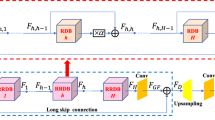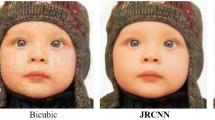Abstract
In many practical situations, images are not only down sampled but also compressed for efficient transmission and storage. JPEG and MPEG-2 compressions often introduce blocking artifacts because they process the data as 8 × 8 blocks. Many of the existing super resolution (SR) methods assume low resolution images as a down sampled version of high resolution (HR) image, and neglect the degradation due to compression. This exacerbates artifacts in the SR image and reduces the user experience. To address the joint deblocking and SR (DbSR), a novel deep network with dense skip connections and dilated convolutions is proposed in this paper, and we name it as DenseDbSR. Recently, many researchers have proposed deeper networks and achieved improvement in the SR performance. However, training deeper networks is very challenging because of the problem of vanishing gradients. Simply increasing the depth of the network leads to cumbersome computational costs. To enlarge the field-of-view (FOV) without increasing the computational cost, the dilated convolution is used. The dilated convolution exponentially expands the FOV and helps to exploit the contextual information efficiently. Moreover, the dense skip connections create short paths for gradients to be back-propagated efficiently and alleviates the problem of vanishing gradients. Furthermore, the network is relieved from the training burden by learning residuals of the SR image instead of learning raw images. From the conducted extensive experimentation, the proposed DenseDbSR network produced better performance in terms of PSNR and SSIM than the compared state-of-the-art methods.















Similar content being viewed by others
References
Arbelaez P, Maire M, Fowlkes C, Malik J (2011) Contour detection and hierarchical image segmentation. IEEE Trans Pattern Anal Mach Intell 33(5):898–916. https://doi.org/10.1109/TPAMI.2010.161
Bevilacqua M, Roumy A, Guillemot C, line Alberi Morel M (2012) Low-complexity single-image super-resolution based on nonnegative neighbor embedding. In: Proceedings of the British Machine Vision Conference, BMVA Press, pp 135.1–135.10. https://doi.org/10.5244/C.26.135
Chen Y, Pock T (2017) Trainable nonlinear reaction diffusion: a flexible framework for fast and effective image restoration. IEEE Trans Pattern Anal Mach Intell 39(6):1256–1272. https://doi.org/10.1109/TPAMI.2016.2596743
Dong C, Deng Y, Loy CC, Tang X (2015) Compression artifacts reduction by a deep convolutional network. In: 2015 IEEE international conference on computer vision (ICCV), pp 576–584. https://doi.org/10.1109/ICCV.2015.73
Dong C, Loy CC, He K, Tang X (2016) Image super-resolution using deep convolutional networks. IEEE Trans Pattern Anal Mach Intell 38(2):295–307. https://doi.org/10.1109/TPAMI.2015.2439281
Huang J, Singh A, Ahuja N (2015) Single image super-resolution from transformed self-exemplars. In: 2015 IEEE conference on computer vision and pattern recognition (CVPR), pp 5197–5206. https://doi.org/10.1109/CVPR.2015.7299156
Kang L, Hsu C, Zhuang B, Lin C, Yeh C (2015) Learning-based joint super-resolution and deblocking for a highly compressed image. IEEE Trans Multimedia 17(7):921–934. https://doi.org/10.1109/TMM.2015.2434216
Kim J, Lee JK, Lee KM (2016) Accurate image super-resolution using very deep convolutional networks. In: 2016 IEEE conference on computer vision and pattern recognition (CVPR), pp 1646–1654. https://doi.org/10.1109/CVPR.2016.182
Kim Y, Soh JW, Park J, Ahn B, Lee H, Moon Y, Cho NI (2019) A pseudo-blind convolutional neural network for the reduction of compression artifacts. IEEE Transactions on Circuits and Systems for Video Technology, pp 1–1. https://doi.org/10.1109/TCSVT.2019.2901919
Kuang P, Ma T, Chen Z, Li F (2019) Image super-resolution with densely connected convolutional networks. Appl Intell 49(1):125–136. https://doi.org/10.1007/s10489-018-1234-y
Ledig C, Theis L, Huszar F, Caballero J, Cunningham A, Acosta A, Aitken A, Tejani A, Totz J, Wang Z, Shi W (2017) Photo-realistic single image super-resolution using a generative adversarial network:105–114. https://doi.org/10.1109/CVPR.2017.19
Lee O, Lee J, Lee D, Kim J (2016) Joint super-resolution and compression artifact reduction based on dual-learning. In: 2016 visual communications and image processing (VCIP), pp 1–4. https://doi.org/10.1109/VCIP.2016.7805543
Rajput SS, Bohat VK, Arya KV (2019) Grey wolf optimization algorithm for facial image super-resolution. Appl Intell 49(4):1324–1338. https://doi.org/10.1007/s10489-018-1340-x
Wang Z, Bovik AC, Sheikh HR, Simoncelli EP (2004) Image quality assessment: from error visibility to structural similarity. IEEE Trans Image Process 13(4):600–612. https://doi.org/10.1109/TIP.2003.819861
Yang J, Wright J, Huang TS, Ma Y (2010) Image super-resolution via sparse representation. IEEE Trans Image Process 19(11):2861–2873. https://doi.org/10.1109/TIP.2010.2050625
Yim C, Bovik AC (2011) Quality assessment of deblocked images. IEEE Trans Image Process 20(1):88–98. https://doi.org/10.1109/TIP.2010.2061859
Zeng K, Ding S, Jia W (2019) Single image super-resolution using a polymorphic parallel cnn. Appl Intell 49(1):292–300. https://doi.org/10.1007/s10489-018-1270-7
Zeyde R, Elad M, Protter M (2010) On single image scale-up using sparse-representations. 6920:711–730. https://doi.org/10.1007/978-3-642-27413-8_47
Zhang K, Zuo W, Chen Y, Meng D, Zhang L (2017) Beyond a gaussian denoiser: residual learning of deep cnn for image denoising. IEEE Trans Image Process 26(7):3142–3155. https://doi.org/10.1109/TIP.2017.2662206
Zhao Y, Jia W, Li L, Cao L, Liu X (2017) Filtered mapping-based method for compressed web image super-resolution. IEEE Access 5:12682–12695. https://doi.org/10.1109/ACCESS.2017.2721458
Author information
Authors and Affiliations
Corresponding author
Ethics declarations
Conflict of interest
The authors declare that they have no conflict of interest.
Additional information
Publisher’s note
Springer Nature remains neutral with regard to jurisdictional claims in published maps and institutional affiliations.
Rights and permissions
About this article
Cite this article
Amaranageswarao, G., Deivalakshmi, S. & Ko, SB. Residual learning based densely connected deep dilated network for joint deblocking and super resolution. Appl Intell 50, 2177–2193 (2020). https://doi.org/10.1007/s10489-020-01670-y
Published:
Issue Date:
DOI: https://doi.org/10.1007/s10489-020-01670-y




